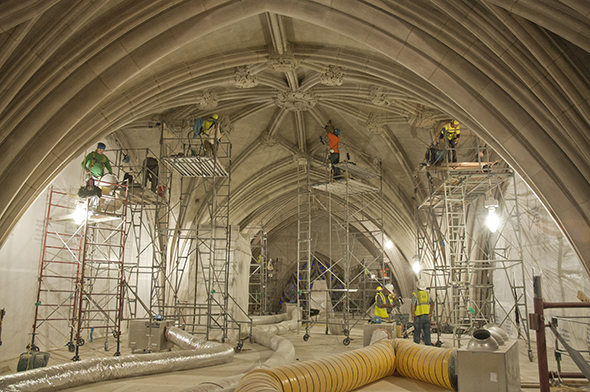Chapel Reopens After Year of Restoration
Crews repaired ceiling, replaced roof tiles and installed new A/C system
Members of the Duke community to share what the Chapel means to them.
On May 11, exactly one year to the day Duke University Chapel closed for a yearlong restoration, the iconic building will reopen to the community.
Throughout the closure, crews worked to rehabilitate the limestone ceiling, replace the original roof and cleaned or polished items from the pews to stained-glass windows. But when Chapel staff return to offices on May 2 and community members step through the doors during a daylong grand reopening celebration May 11, they shouldn’t notice a thing.
“If we did our job, it’ll all look the same,” said Ray Walker, a project manager with Facilities Management who oversaw the work.
The $19.2 million project was the first major restoration of the building since it was built in the 1930s. Aside from changes like a new cooling system and LED chandelier lights, the restoration work did not alter the elements that made the Chapel a historic structure, even after installing more than 26 miles of electrical wire, cable and conduits.
Inside the Chapel, crews carefully replaced damaged mortar from limestone ribs that hold up the ceiling. As a new air conditioning system was installed, temperatures near the ceiling sometimes hovered around 100 degrees during the hottest parts of the year. That wasn’t nearly as bad as workers outside replaced the Chapel’s original roof tiles of lead-coated copper. At the summer’s peak, measured surface temperatures got up to 128 degrees, so workers accessed five different cooling stations on scaffolding surrounding the building.

Also during the renovation, seven stained-glass windows were removed and deconstructed so they could be shipped to four different cleaning services that specialized stained glass. Sections were sent to two locations in New York and one each in Virginia and Michigan while each window’s lead caning was repaired.

Marble floors were cleaned and resealed, a high-voltage transformer was replaced and pews – taken out of the Chapel before work began – were refinished to preserve the elongated benches for another generation of visitors. Woodwork in the nave and chancel was also refinished. Portions of the Chapel's organs, which could not be moved, were sealed as protection from mortar dust.
“The restoration activities were like a dance,” Walker said. “It was all about timing things out so you never step on people’s feet.”

Each pew, window and chandelier is now back in place in the Chapel, but one big task had to wait until the very end – tuning the building’s Flentrop, Aeolian and Brombaugh organs, which have been silent for a year.
John Santoianni, curator of organs and harpsichords, was the only non-construction personnel on-site during the restoration, using the time to make repairs to some pipes, harpsichords and other maintenance tasks. Since mid-April, with help from pipe organ specialists from Connecticut’s Foley-Baker, Inc., he’s overseen the retuning and intricate tweaking of the organs to be ready when the Chapel reopens to the public May 11. This week, the music will greet about 25 staff who return to their basement offices inside Duke Chapel after spending the past year at locations spread across East, Central and West campuses and Durham.
“I’m looking forward to everyone finally hearing the organs again,” Santoianni said. “They’ve been shrouded in plastic and the circuit breakers had been turned off, so nobody could have turned them on even if they wanted. It’ll be nice to hear their voices.”
See historical photos of Duke University Chapel from its construction to today in this video: